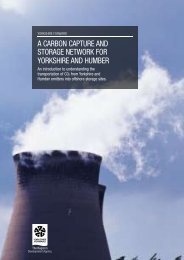Final report for One North East And NEPIC 21/12/10 - The Carbon ...
Final report for One North East And NEPIC 21/12/10 - The Carbon ...
Final report for One North East And NEPIC 21/12/10 - The Carbon ...
You also want an ePaper? Increase the reach of your titles
YUMPU automatically turns print PDFs into web optimized ePapers that Google loves.
7 Conclusions and Recommendations<strong>The</strong> case <strong>for</strong> a Tees CCS network<strong>Final</strong> Report<strong>The</strong> analysis presented in this <strong>report</strong> identifies that manufacturing and power industrywithin the Tees Valley are critical to the economy of the <strong>North</strong> <strong>East</strong> of England. <strong>The</strong>commercial viability of several of these businesses is threatened by increasing carbonprices and carbon regulation. This could result in these businesses relocating to countrieswith lower environmental regulation, resulting in severe impacts to the <strong>North</strong> <strong>East</strong>economy. Whilst this issue has been recognised by the Committee on Climate Changeand UK Government, at present there does not appear to be a coherent national (orEuropean) strategy to resolve this.A CCS network offers the potential to trans<strong>for</strong>m the Tees Valley from an area threatenedby tightening carbon regulation to a preferred location <strong>for</strong> European manufacturing industryand fossil and biomass power stations. A CCS network developed in the Tees Valley istechnically feasible, could deliver up to 8% of the UK‟s required CO 2 reduction <strong>for</strong> 2030,and is already understood and has the support of several local stakeholders.<strong>The</strong> average abatement cost of a „Medium‟ sized CCS system connecting 8 point sourcesis estimated at ca. £48/t CO 2 abated. Of this, £7/t CO 2 is expected as a cost of service <strong>for</strong>use of a common transport network with a maximum capacity of 22 Mt CO 2 /year. <strong>The</strong>reare at least five possible candidates <strong>for</strong> CCS demonstration projects in the <strong>North</strong> <strong>East</strong> anyof which could act as an anchor customer <strong>for</strong> a CCS network. A shared pipeline networkreduces the cost to all users, potentially allowing some users to connect at marginal costand difficulty.<strong>The</strong> actual cost of service will depend on a range of inter-related factors. Demonstrationfunding, use of nearby sinks, favourable financing conditions and early connections ofsubsequent sources could each reduce network cost of service below £5/t CO 2 . Incontrast, reduced utilisation, long offshore pipelines or high risk premia could each drivecost of service above £<strong>10</strong>/t CO 2 which would likely render the network uneconomic.Combinations of factors obviously have a more profound impact on overall economics thanindividual factors alone. An agreement to purchase CO 2 by an oil company <strong>for</strong> use in CO 2 -enhanced oil recovery would dramatically improve the economics of CO 2 pipeline, butenthusiasm <strong>for</strong> this within the oil industry under current market arrangements is limited.<strong>The</strong> absence of a dominant source, and the existing experience <strong>for</strong> industrial emitters insharing pipeline infrastructure suggests that economic regulation to avoid monopolisticpractices may not be necessary. An „Open Season‟, whereby existing emitters purchasecapacity rights or tradable options, may be used by demonstration projects to leveragesome private investment, although this will likely be very limited at this stage of technologymaturity, regulatory clarity and with current carbon pricing signals. At present the capitalmarkets are unlikely to provide debt finance. However, in the period up to and beyond2020, the economic signals and legal requirements <strong>for</strong> carbon reduction are likely tobecome significantly clearer, which offers the potential to refinance initial investment atlower cost.7.1 Barriers to delivering a <strong>North</strong> <strong>East</strong> CCS network<strong>The</strong> key barrier identified in this study <strong>for</strong> the development of a <strong>North</strong> <strong>East</strong> CCS network isinsufficient long-term clarity on policies, legislation, regulation, market incentives andsocial acceptance <strong>for</strong> the energy and climate sector in general, and on CCS specifically.65







